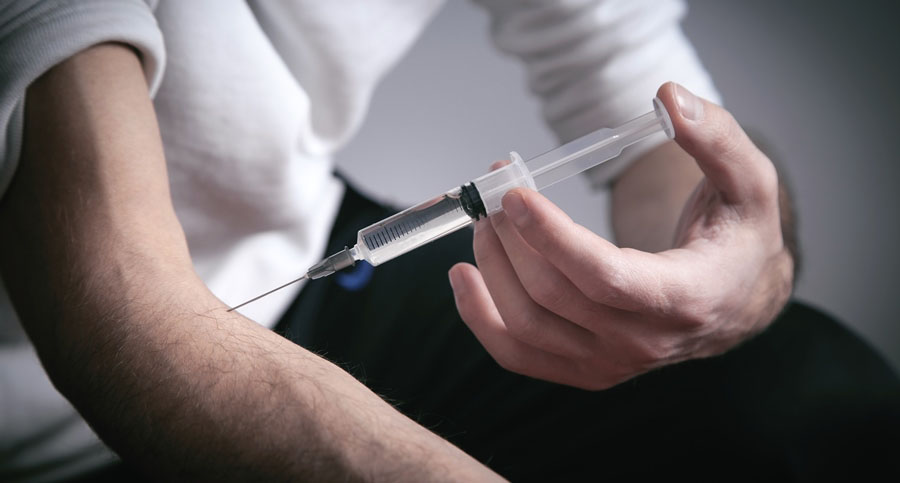When you’re concerned that someone you care about might be struggling with an addiction to intravenous drugs, such as heroin, you might have heard that visible “track marks” are a common sign you should look for. However, what are they, and what do track marks look like?
We’re here to help. This article will provide all the details you need to identify track marks or addiction to injectable substances and resources to get on the right track toward recovery. Keep reading for all the details.
What Are Track Marks?
Track marks are small puncture wounds that can appear across the body but are most common along the arms, especially in the crooks of the elbows. They might also be referred to as needle marks or injection marks.
Track marks are a common sign of intravenous drug use and something that a loved one or treatment professional might look for to identify if someone is struggling with addiction. The most common injectable drugs that cause track marks are:
- Opioids, such as heroin, oxycodone (OxyContin), hydrocodone (Vicodin), morphine, or fentanyl
- Cocaine
- Methamphetamine
Along with these drugs, other less common drugs might also be injected, such as PCP, ketamine, Adderall, or other prescription stimulants.
Appearance of Track Marks
In the early stages of intravenous drug use, track marks aren’t as easy to identify. They’ll typically look like little red needle marks, similar to what your skin might have after getting a shot at the doctor’s office. You might not even notice it when just glancing at someone’s arm.
However, as the drug use continues, the appearance and state of the marks will worsen over time. It’s common for the injection site to start scabbing over since the skin is trying to heal. Bruising or discoloration might also begin appearing in that area due to the physical impact of repeated injections.
If intravenous drug use persists past that point (typically one year or more of drug abuse), the injection site might scar or start to harden up. This will make it harder for the individual to continue injecting into the veins in that area. Therefore, they’ll switch to injecting in other places on the body.
Other Places You Might See Track Marks
Most people will begin injecting into the crooks of the elbows and then move to the wrists or armpits, where veins are still very accessible. After the arms, other common injection sites are the femoral veinous sinus (a vein that runs from the knee to the groin and into the abdomen), the neck, or the feet.
When you notice track marks in these areas, it’s often a sign of a more serious addiction, and it’s important that the person struggling receives proper treatment and care to recover.
Injecting outside the arms also comes with more dangers, such as being more likely to miss the vein, which could cause cysts and infections, or being more likely to have smaller veins collapse.
Signs and Symptoms Beyond Visual Appearance

As mentioned, it’s not always easy to notice track marks in the early stages of intravenous drug use. Plus, those struggling might also do things like wear long-sleeved shirts to cover up the marks on their arms when they’re around other people.
That said, there are still other signs and symptoms to help you identify if someone you care about might be struggling with a substance use disorder involving injectable drugs. Those signs include:
- Experiencing several highs and lows in daily life, such as going from being overtly content or energetic to feeling low and irritable
- Trouble concentrating or thinking, potentially affecting performance at work or school
- Increased levels of fatigue or even unexpectedly falling asleep
- Withdrawing from friends, family, or activities once enjoyed
- Irrational behavior or legal problems
- Financial difficulties
- Trying to quit and not being able to
- Having physical or mental withdrawal symptoms, like shaking or increased anxiety when not taking drugs
- Treating infections, bruising, or swelling in common injection points
When someone is showing these symptoms or other signs you believe might indicate struggles with drug use, make an effort to be there for them and encourage them to seek help. Visiting a local treatment center and getting a diagnosis from a medical professional is a good first step.
Health Risks Associated with Track Marks
When someone is frequently using intravenous drugs, it can have health risks both at the injection site and throughout the body.
Health Risks at the Injection Site
Potential health risks at the injection site are:
- Collapsed veins – repeated injections can cause the vein to stop pumping blood.
- Skin infections – usually caused by bacteria coming into contact with the injection site.
- Skin popping – happens when someone accidentally injects into the muscle rather than a vein, causing lumps to form beneath the skin.
Health Risks Throughout the Body
Other potential health risks throughout the body from injecting drugs like heroin or cocaine include:
- Higher risk of blood-borne viruses like HIV or hepatitis from dirty needles
- Clogged blood vessels in the liver, lungs, kidneys, or brain
- Lowered immune system
- The death of cells in vital organs
- Potential for overdose
- Increased risk of heart disease or hypertension
These health risks are very serious and can cause life-long issues in some cases. That’s why getting treatment for those struggling with addiction and showing signs like track marks is so crucial.
Preventative Measures and Treatment

Ultimately, the best way to prevent track marks and the dangerous side effects of intravenous drug use is to avoid using these substances.
If you’re prescribed medications like opioids, it’s never a good idea to experiment with them by taking higher doses than recommended or breaking them down and injecting them. These drugs can be very addictive when misused or abused, so don’t take them lightly and follow the directions from your doctor to stay safe.
If you or someone you care about is showing signs of track marks or intravenous drug use, there are resources that can help with recovery to avoid negative complications.
Going to a treatment center to get a diagnosis and learn about rehabilitation options is a good first step.
The typical process during treatment will include a medical detox to remove the drugs from your system and manage withdrawal symptoms. After detox, a full residential treatment program and aftercare, like following a 12-step program or attending therapy sessions, will help with long-term recovery from substance abuse.
Conclusion
Track marks are a common sign of intravenous drug abuse involving substances like heroin, cocaine, or methamphetamine. Long-term intravenous drug use can lead to negative health consequences both at the injection site and throughout the body, making treatment and prevention essential.
If you or someone you care about is struggling with intravenous drug use or addiction to other substances, you don’t have to go through it alone. Treatment centers like ours can help with diagnosis, detox, and residential treatment to get on the right track to recovery. We’ll create an in-depth plan tailored to your needs to ensure lasting success.
Contact us today to learn more about how we can help.
References
- Karimi, M., Ghaheri, H., Assari, S., Ahmadi, K., Moghani Lankarani, M., Moghani Lankarani, R., Narenjiha, H., Rafiey, H., Tavakoli, M., & Jafari, F. (2014). Drug Injection to Sites other than Arm: A Study of Iranian Heroin Injectors. Frontiers in Psychiatry, 5. https://doi.org/10.3389/fpsyt.2014.00023
- Coffin, P. O., Coffin, L. S., Murphy, S., Jenkins, L., & Golden, M. R. (2012). Prevalence and Characteristics of Femoral Injection among Seattle-Area Injection Drug Users. Journal of Urban Health, 89(2), 365–372. https://doi.org/10.1007/s11524-011-9664-4
- National Institute on Drug Abuse. (2018, June). What are the medical complications of chronic heroin use? National Institute on Drug Abuse. https://nida.nih.gov/publications/research-reports/heroin/what-are-medical-complications-chronic-heroin-use
- Petkovska, L., Chibishev, A., Stevcevska, A., Smokovski, I., Petkovski, D., & Antova, E. (2017). Multi–System Complications after Intravenous Cocaine Abuse. Open Access Macedonian Journal of Medical Sciences, 5(2), 231–235. https://doi.org/10.3889/oamjms.2017.046



